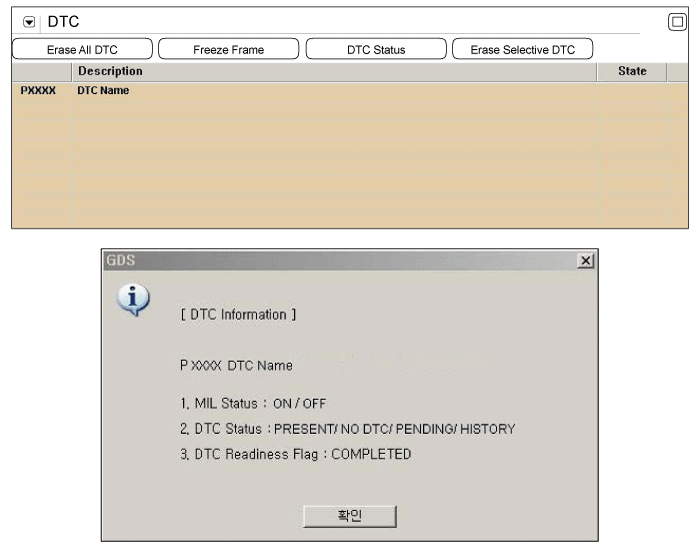
The evaporative emission
control system prevents hydrocarbon (HC) vapors from the fuel tank from
escaping into the atmosphere where they could form photochemical smog.
Gasoline vapors are collected in the charcoal canister. The PCM controls
the Purge Control Solenoid Valve (PCSV) to purge any collected vapors from
the canister back to the engine for combustion. This valve is actuated by
the purge control signal from the PCM and controls fuel vapor from the
canister to the intake manifold.
Checking output signals
from PCSV every 10 sec. under detecting condition, if signals indicating
short to battery in the circuit are detected for more than 5 sec., PCM
sets P0445. MIL(Malfunction Indication Lamp) turns on when the malfunction
lasts till consecutive 2 driving cycle.
Item
|
Detecting
Condition
|
Possible cause
|
DTC
Strategy
|
|
| •
|
Short to battery in
harness |
|
EnableConditions
|
| •
|
11V ≤ Battery voltage ≤
16V |
| •
|
Above enable conditions are met > 0.5
sec. | |
Threshold
value
|
|
DiagnosisTime
|
| •
|
Continuous
(More than 5 sec.failure for every 10
sec.test) | |
MIL On
Condition
|
|
Item
|
Coil
resistance(Ω)
|
PCSV
|
19.0 ~ 22.0Ω
(at 20°C / 68°F)
|


The Purge Control
Solenoid Valve(PCSV) is open or closed by PCM and vacuum of intake
manifold. At opening, fuel vapor from canister enters into intake
manifold. To prevent vacuum from forming inside canister, PCM controls to
open it. This photo shows the signal waveform of PCSV operating
normally.
| 1. |
Check DTC Status
| (1) |
Connect scantool to Data Link
Connector(DLC). |
| (3) |
Select "DTC" button, and then Press "DTC
Status" to check DTC's information from the DTCs
menu. |
| (4) |
Read "DTC Status"
parameter.

|
| (5) |
Is parameter displayed "Present
fault"?
|

|
▶ Go
to "Terminal and connector inspection"
procedure.
|
|

|
▶
Fault is intermittent caused by poor contact in the
sensor's and/or PCM's connector or was repaired and PCM
memory was not cleared. Thoroughly check connectors for
looseness, poor connection, ending, corrosion,
contamination, deterioration, or damage. Repair or
replace as necessary and go to "Verification of Vehicle
Repair"
procedure.
|
| |
| Terminal And Connector
Inspection |
| 1. |
Many malfunctions in the electrical system are
caused by poor harness and terminal condition. Faults can also be
caused by interference from other electrical systems, and mechanical
or chemical damage. |
| 2. |
Thoroughly check connectors for looseness,
poor connection, bending, corrosion, contamination, deterioration,
or damage. |
| 3. |
Has a problem been found?
|

|
▶ Repair as
necessary and go to "Verification of Vehicle Repair"
procedure
|
|

|
▶ Go to "
Control Circuit Inspection "
procedure.
|
|
| Control Circuit
Inspection |
■ Check short to battery in harness
| 1. |
IG "OFF" and disconnect PCSV
connector. |
| 3. |
Measure voltage between control terminal of
PCSV harness connector and chassis ground.
Specification
: Approx.0 V
| |
| 4. |
Is the measured voltage within
specification?
|

|
▶ Go to
"Component Inspection" procedure.
|
|

|
▶ Repair
short to battery in harness, and go to " Verification of
Vehicle Repair"
procedure.
|
|
■ Check PCSV
| 1. |
IG "OFF" and disconnect PCSV
connector. |
| 2. |
Measure resistance between power and control
terminals of PCSV connector.(Component side)
Specification
: 19.0 ~ 22.0Ω ( at 20°C/
68°F)
| |
| 3. |
Is the measured resistance within
specification?
|

|
▶
Substitute with a known - good PCM and check for proper
operation. If the problem is corrected, replace PCM and go to
"Verification of Vehicle Repair" procedure..
|
|

|
▶
Substitute with a known - good PCSV and check for proper
operation. If the problem is corrected, replace PCSV and go to
"Verification of Vehicle Repair"
procedure.
|
|
There is a memory reset function on
scantool that can erase optional parts automatically detected
and memorized by PCM. After testing PCM on the vehicle, use
this function to reuse the PCM on the
others | |
| Verification Of Vehicle
Repair |
After a repair, it is
essential to verify that the fault has been corrected.
| 1. |
Connect scantool and select "DTC"
button. |
| 2. |
Press "DTC Status" button and confirm that
"DTC Readiness Flag" indicates "Completed". If not, drive the
vehicle within conditions noted in the freeze frame data or enable
conditions |
| 3. |
Read "DTC Status"
parameter |
| 4. |
Is parameter displayed "History(Not Present)
fault"?
|

|
▶ System
performing to specification at this time. Clear the
DTC
|
|

|
▶ Go to the
applicable troubleshooting
procedure.
|
|